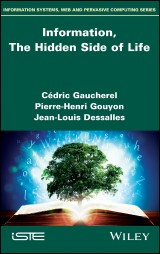Details
Information, The Hidden Side of Life
1. Aufl.
|
139,99 € |
|
| Verlag: | Wiley |
| Format: | EPUB |
| Veröffentl.: | 31.12.2018 |
| ISBN/EAN: | 9781119579359 |
| Sprache: | englisch |
| Anzahl Seiten: | 224 |
DRM-geschütztes eBook, Sie benötigen z.B. Adobe Digital Editions und eine Adobe ID zum Lesen.
Beschreibungen
<p>This book explores the unity of life. It proposes that the concept of information is the inner essence of what we today call life.<br /> <br /> The importance of information for our species is obvious. Human beings are highly dependent on information, constantly exchanging with conspecifics. In a less apparent way, we are the product of genetic and epigenetic information which determines our development in a given environment from a fertilized egg to the adult stage. Even less apparent is that information plays a determining role in ecosystems. This observation may include the prebiotic systems in which life emerged.<br /> <br /> Our claim is that Nature processes information continuously. This means that even beyond living entities, we can see messages and decoding procedures. Nature can be said to send messages to its own future and then to decode them. Nature “talks” to itself! The systematic organization of messages suggests that, in some respects, we should even speak of the “languages” of Nature. </p>
<p>Preface ix</p> <p>Introduction xiii</p> <p>Acknowledgments xxiii</p> <p><b>Chapter 1 Human and Animal Communication 1</b></p> <p>1.1 Language, that amazing thing 1</p> <p>1.2 The mechanics of language 2</p> <p>1.3 What is syntax? 10</p> <p>1.4 Meaning 11</p> <p>1.5 Beyond meaning 13</p> <p>1.6 Non-human languages 14</p> <p>1.7 Types of language 17</p> <p>1.8 Why give information? 23</p> <p>1.9 The autonomy of information 28</p> <p>1.10 Language and information 31</p> <p><b>Chapter 2 Genetic Information 33</b></p> <p>2.1 A central concept in biology 33</p> <p>2.2 Epigenetic information 40</p> <p>2.3 The environment 42</p> <p>2.4 Information: from replication to reproduction 48</p> <p>2.5 Mutation and selection 49</p> <p>2.6 The story of the message: phylogeny and coalescence 52</p> <p>2.7 The point of view of the reading system 58</p> <p>2.8 We cannot see the wood for the trees 60</p> <p>2.9 The tree and the web and some complexities there! 64</p> <p>2.10 When information and individual can no longer be confused 66</p> <p>2.11 Conflicts and levels of integration: avatars 71</p> <p>2.12 Sociobiology, altruism and information 73</p> <p>2.13 The “all genetics” versus epigenetics 75</p> <p>2.14 What is Life? 77</p> <p><b>Chapter 3 Ecosystem and Information 79</b></p> <p>3.1 An information-centered perspective of the ecosystem 79</p> <p>3.2 Reservoirs of ecosystemic information 82</p> <p>3.3 Biodiversity: an ecosystem made up of individuals 87</p> <p>3.4 Phylogeny of communities: biology in the arena 90</p> <p>3.5 The ecosystem: a physical system or a biological system? 92</p> <p>3.6 An ecosystem made up of matter and energy 96</p> <p>3.7 Failure of the physical approach 98</p> <p>3.8 Physics has not said its last word 106</p> <p>3.9 The great challenges of ecology 110</p> <p>3.10 Flow and balance of ecosystemic information 117</p> <p>3.11 Ecosystemic codes 121</p> <p>3.12 The languages of the ecosystem 129</p> <p><b>Chapter 4 Can We Define Information? 133</b></p> <p>4.1 Information as surprise 133</p> <p>4.2 Information measured by complexity 136</p> <p>4.3 Information as organized complexity 137</p> <p>4.4 Information as compression 139</p> <p>4.5 Coding and information reading 142</p> <p>4.6 Memory 145</p> <p><b>Chapter 5 Evolution of Information 149</b></p> <p>5.1 In the beginning was structure 149</p> <p>5.2 The first languages were ecosystemic 151</p> <p>5.3 The replicators and the conservators 152</p> <p>5.4 Biological languages 155</p> <p>5.5 Information selection 156</p> <p>5.6 Messages and languages 158</p> <p>5.7 The complexification of codes. 159</p> <p>5.8 Complexification of languages 161</p> <p>5.9 The re-creation of life 164</p> <p>5.10 And what about tomorrow? 166</p> <p>References 169</p> <p>Index 179</p>
<p><b>Cédric Gaucherel</b> is a researcher at INRA and holds a PhD in Astrophysics and an HdR in Theoretical Ecology. Among various environmental subjects, he studies ecosystem functioning with cutting-edge concepts and mathematical models.</p> <p><b>Pierre-Henri Gouyon</b> is a Professor at the Muséum National d’Histoire Naturelle, AgroParisTech, Sciences Po and the Ecole Normale Supérieure in France. He is a researcher studying evolution and its mechanisms at all scales, from genes to ecosystems.</p> <p><b>Jean-Louis Dessalles</b> is a Professor at Télécom ParisTech, France, and is involved in the quest for fundamental principles underlying the language faculty and its biological origins. He also uses mathematical modeling to test the hypothesis of the political origins of human language.</p>














